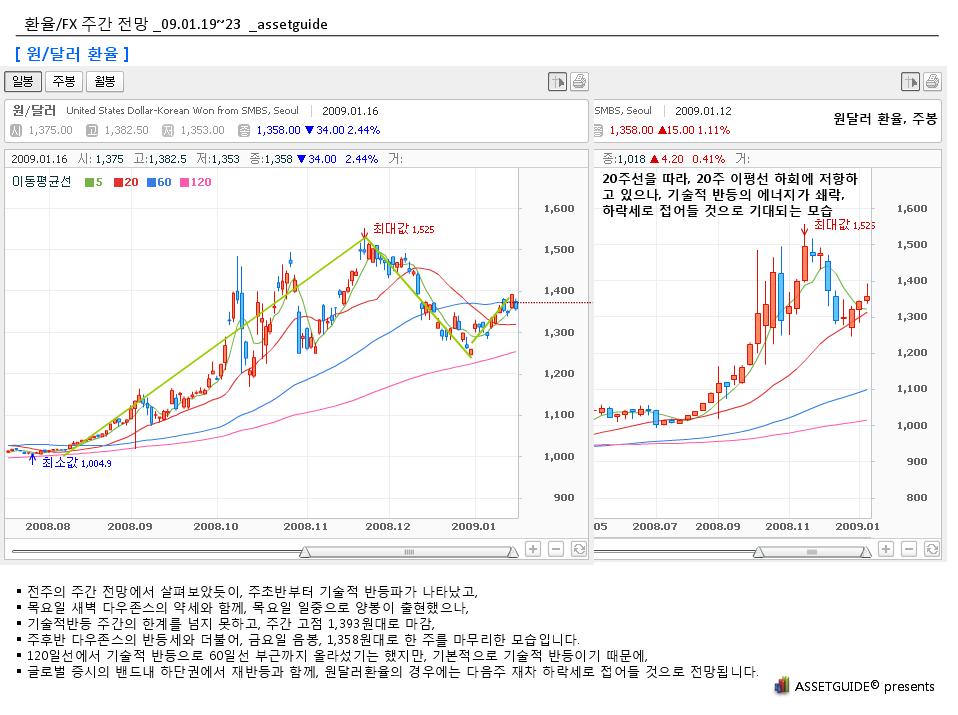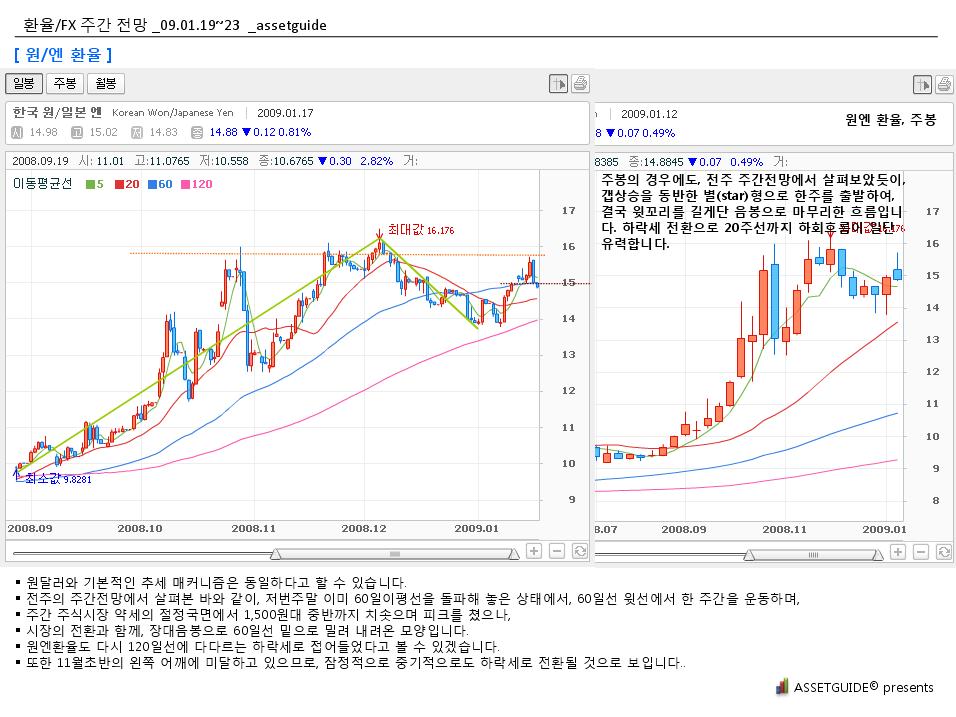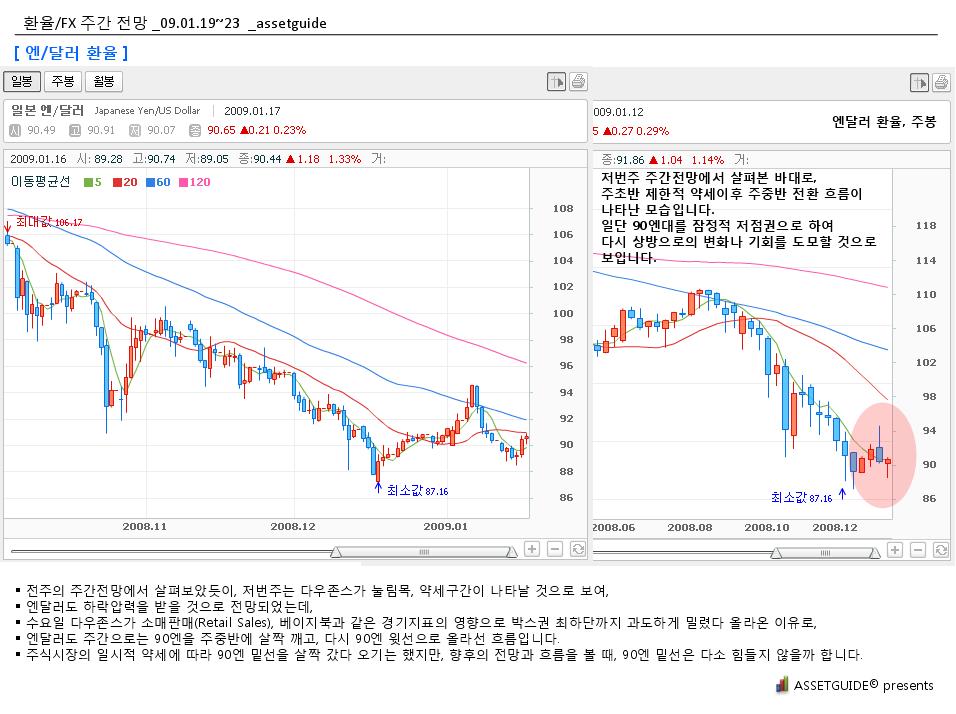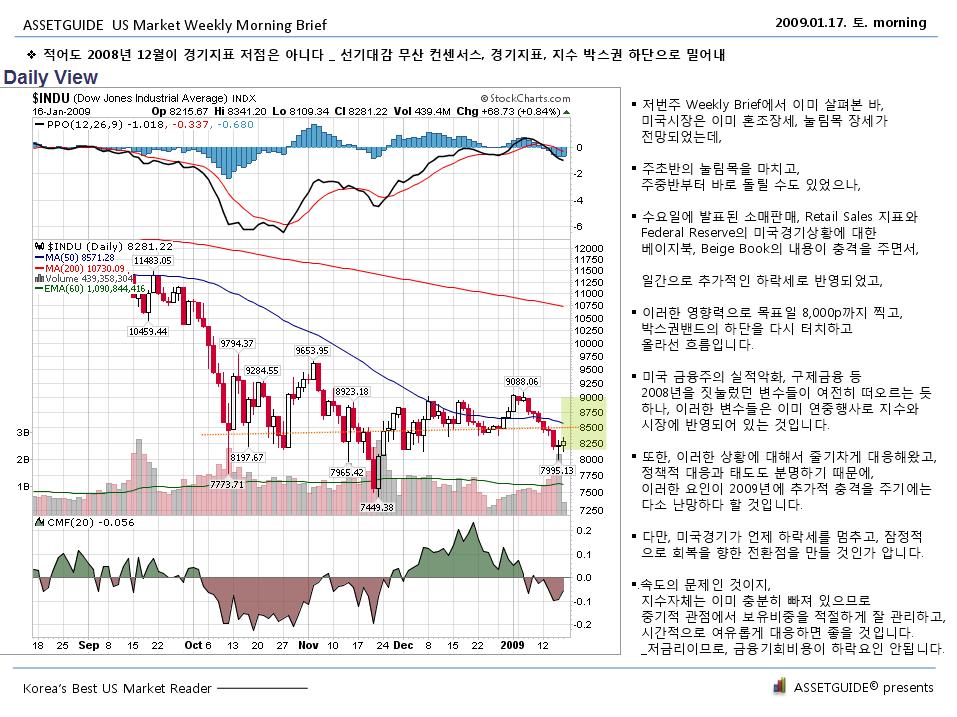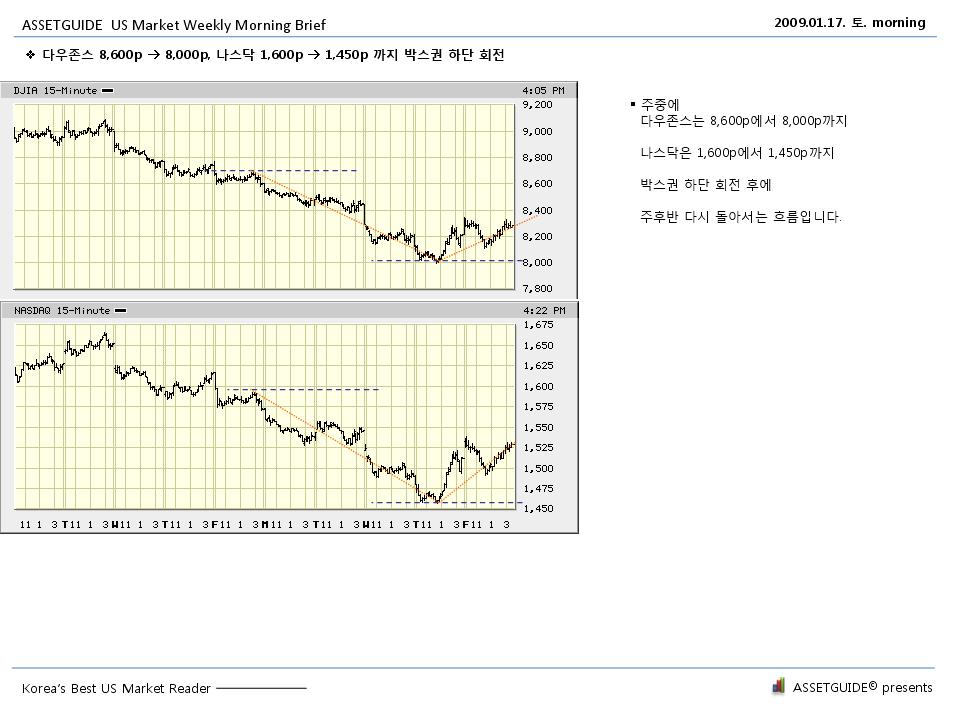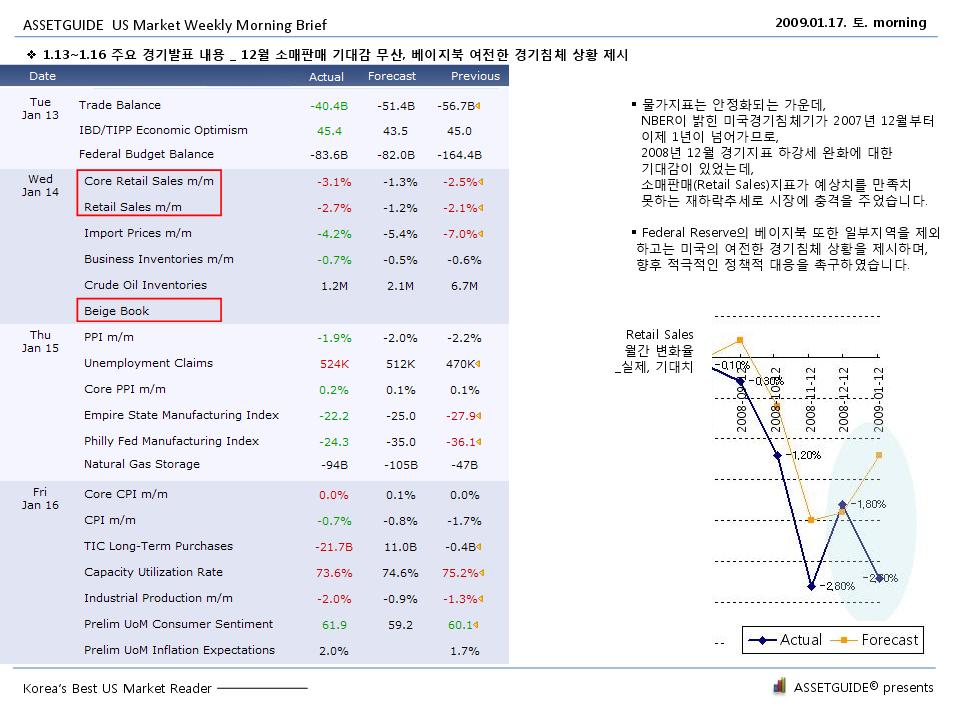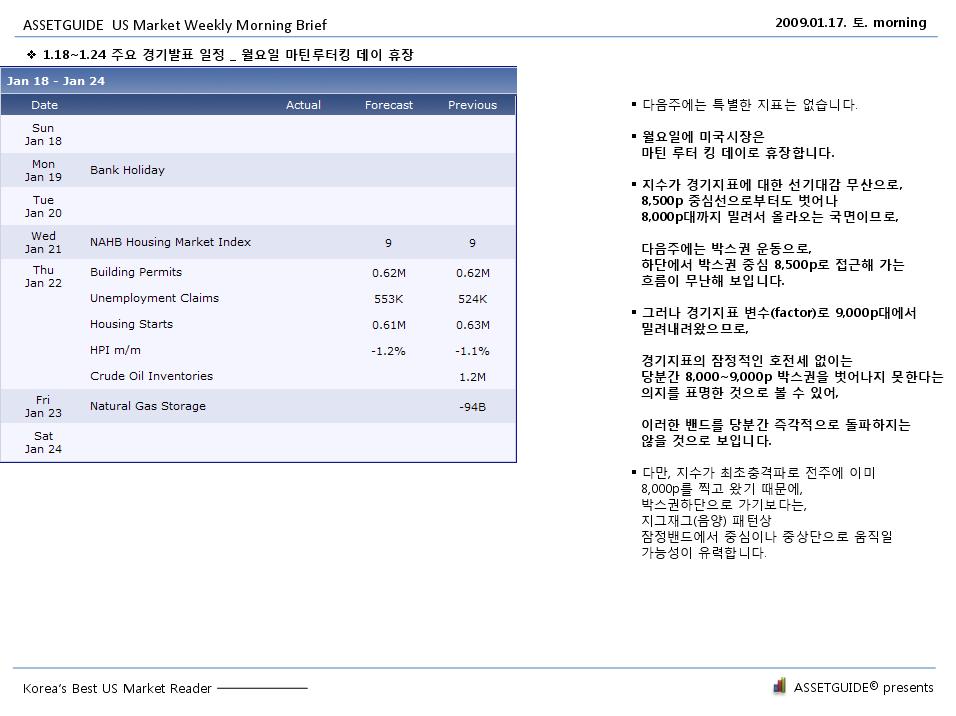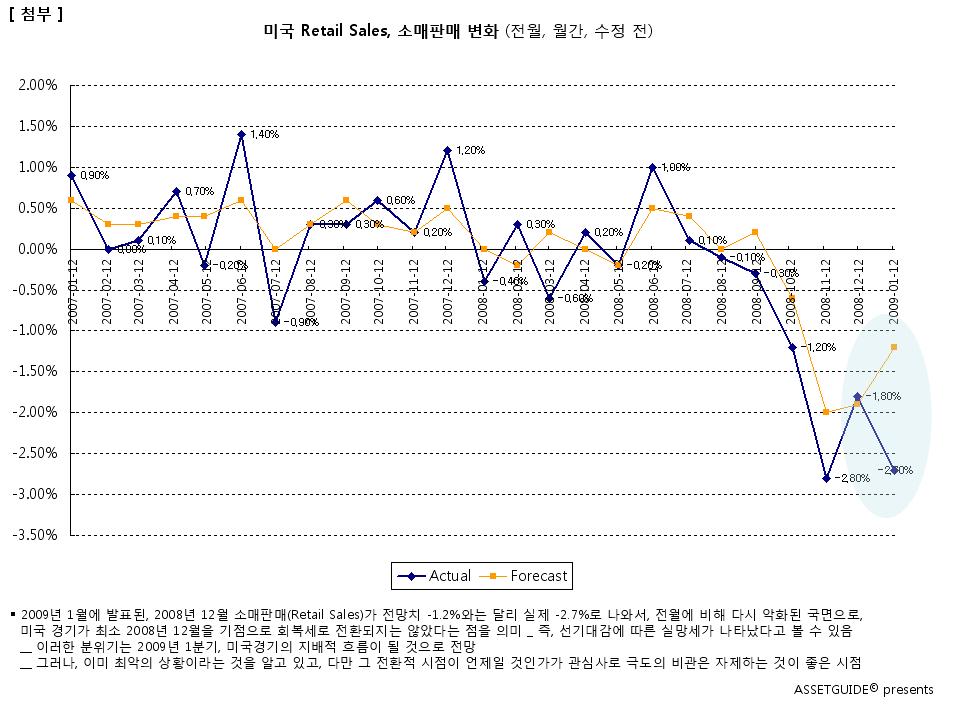|
|
||||
다음은 2009년 4월자 미국 베이지북(Beige Book) 주요내용입니다. 2009년 4월 15일 발표 (현지)
Summary
Prepared at the Federal Reserve Bank of Dallas based on information collected on or before April 6, 2009. This document summarizes comments received from business and other contacts outside the Federal Reserve and is not a commentary on the views of Federal Reserve officials.
April 15, 2009
Reports from the Federal Reserve Banks indicate that overall economic activity contracted further or remained weak. However, five of the twelve Districts noted a moderation in the pace of decline, and several saw signs that activity in some sectors was stabilizing at a low level.
전반적인 경제 활동은 침체를 지속하고 여전히 약세이지만, 12개 지역 중 5개 지역은 침체 속도가 완화하고 있고 미약하지만 몇몇 산업 섹터 활동은 약한 정도로 완화되는 징후가 나타나고 있습니다.
(*주: 베이지북의 주요 관찰 지역은, Districts 는 Boston, New York, Philadelphia, Cleveland, Richmond, Atlanta, Chicago, St.Louis, Minneapolis, Kansas City, Dallas, San Francisco 입니다.)
Boston
New York
Philadelphia
Cleveland
Richmond
Atlanta
Chicago
St. Louis
Minneapolis
Kansas City
Dallas
San Francisco
Manufacturing activity weakened across a broad range of industries in most Districts, with only a few exceptions. Nonfinancial service activity continued to contract across Districts. Retail spending remained sluggish, although some Districts noted a slight improvement in sales compared with the previous reporting period. Residential real estate markets continued to be weak. Home prices and construction were still falling in most areas, but better-than-expected buyer traffic led to a scattered pickup in sales in a number of Districts. Nonresidential real estate conditions continued to deteriorate. Difficulty obtaining commercial real estate financing was constraining construction and investment activity. Spending on business travel declined as corporations cut back. Reports on tourism were mixed. Bankers reported tight credit conditions, rising delinquencies, and some deterioration of loan quality.
Agricultural conditions were generally favorable across Districts, although drought conditions persisted in the Dallas and San Francisco Districts. The Districts reporting on energy said reduced demand, high inventories, and lower prices led to steep cutbacks in oil and natural gas drilling and production activity. The Minneapolis, Kansas City, and Dallas Districts noted declines in employment in the oil and gas extraction industry.
Downward pressure on prices was reported across Districts. Wage and salary pressures eased as labor markets weakened in all Districts, and many contacts continued to report job cuts and wage and hiring freezes. Employment continued to decline across a range of industries, with only scattered reports of hiring.
Manufacturing
Manufacturing activity continued to decline in most Districts and across a wide range of industries. Several reports, however, noted that the pace of decline had slowed or that factory activity had stabilized. The Boston, Philadelphia, Richmond, Atlanta, St. Louis, Minneapolis, and San Francisco Districts cited decreases in production. The Chicago and Kansas City Districts said declines in production had slowed. The Cleveland District noted some leveling off in declines in new orders, and the New York and Dallas Districts noted that demand was beginning to bottom out following steep declines. Orders and shipments of capital goods, autos, paper, and construction-related equipment and products such as metals, wood products, lumber and electrical machinery remained mostly sluggish and below year-ago levels, with the Chicago District noting an increase in order cancellations and deferral requests. Aircraft makers in the Chicago District noted declines in demand, while aerospace manufacturers in the San Francisco District reported that a drop in airline passenger traffic and cargo capacity had spurred order cancellations and delivery deferrals.
In contrast, orders and sales of high-tech equipment firmed somewhat at very weak levels in the Dallas and San Francisco Districts. Defense firms in the Boston and Cleveland Districts reported solid activity. Food manufacturers saw sales gains in the Philadelphia and San Francisco Districts, and a food manufacturer in the St. Louis District noted plans to open a new plant. Pharmaceutical firms in the Boston and Chicago Districts continued to see solid demand; petrochemical producers in the Dallas District noted a slight turnaround in operating rates.
Manufacturers' assessments of future factory activity improved marginally over the survey period as well, with contacts in the Boston, New York, Philadelphia, Atlanta, and Kansas City Districts noting a slight upturn in the outlook for production and sales. Capital expenditure plans remained on hold across most regions, and the Boston, Philadelphia, and Cleveland Districts noted cuts in capital budgets.
Nonfinancial Services
Districts that report on nonfinancial business services said demand continued to fall across most industries. Providers of health-care services noted further declines in activity, and contacts in several Districts noted demand for professional services, such as architecture, business consulting and legal services, remained weak. Demand for IT services was mixed. Among service firms, there were reports of customers delaying payments or asking for price reductions, and receivables were harder to collect.
While there were scattered reports of optimism, temporary staffing firms generally continued to report weak conditions. Firms in the Dallas District were not renewing contracts on current personnel, and the New York District characterized the supply of available workers as "inexhaustible."
Shipping activity continued to fall over the past six weeks as both domestic and international demand remained dampened. Contacts in several Districts said shipments of construction-related manufacturing products continued to drop at a substantial pace.
Consumer Spending and Tourism
Consumer spending remained generally weak. However, several Districts said sales rose slightly or declines moderated compared with the previous survey period. In particular, the Boston, Cleveland, and Chicago Districts reported an improvement in sales. Purchases of big ticket and luxury items continued to decline while spending on food and necessities fared better. The Philadelphia, Dallas, and San Francisco Districts reported that consumers were looking for value, and were opting for lower-priced, private label products over higher-priced alternatives. Retailers kept inventories lean, in line with the slow pace of sales, and most expect demand to stay at current low levels over the next few months.
Auto dealers continued to struggle, and overall vehicle sales were sluggish in all reporting Districts as weak demand and tight credit continued to limit sales. Used vehicle sales improved slightly in the Boston, Cleveland, Kansas City, and San Francisco Districts, but new car sales remained feeble. Dealers in the Philadelphia District reported difficulty in obtaining financing for inventory purchases, and a few dealerships in the St. Louis District went out of business, but dealers in the Cleveland District reported minimal problems with floor-plan financing. While auto dealers in the Boston, Cleveland, and Kansas City Districts noted some improvements in the outlook, those in the Philadelphia and Dallas Districts expect continued weakness.
Travel and tourism activity contracted further in several reporting Districts, as households and businesses continued to scale back on discretionary and travel spending. Tourist spending in the New York, Minneapolis, and San Francisco Districts saw double-digit declines compared with the prior year. Airlines in the Dallas District and hotel contacts in the Kansas City District reported weakening demand for business travel, while the Atlanta District noted convention cancellations. Restaurants continued to see sluggish activity in the Kansas City and San Francisco Districts, which prompted further layoffs and closures in the latter region. In contrast, mountain resorts in the Richmond District said ski season demand was on par with last year, and cruise liners in the Atlanta District reported that deep discounting spurred bookings.
Real Estate and Construction
Housing markets remained depressed overall, but there were some signs that conditions may be stabilizing. Many Districts said factors such as homebuyer tax credits, low mortgage rates, and more affordable prices led to a rising number of potential buyers. The Richmond, Atlanta, Minneapolis, Kansas City, and San Francisco Districts noted a modest improvement in sales in some areas.
New home construction activity fell further, however, as inventories remained elevated. Nonetheless, several Districts, including Atlanta and Kansas City, said that inventories of unsold homes had turned down slightly.
Home prices continued to decline in most Districts, although a few reports noted that prices were unchanged or that the pace of decline had eased. Low mortgage rates were fueling refinancing activity. Outlooks for the housing sector were generally more optimistic than in earlier surveys, with respondents hopeful that increased buyer interest would lead to better sales.
Nonresidential real estate conditions continued to deteriorate over the past six weeks. Demand for office, industrial and retail space continued to fall, and there were reports of increases in sublease space. Rental concessions were rising. Property values moved lower as reality "set in." Construction activity continues to slow, and several Districts noted increased postponement of both private and public projects. Nonresidential construction is expected to decline through year-end, although there were some hopeful reports that the stimulus package may lead to some improvement.
Commercial real estate investment activity weakened further. Contacts said a decline in credit availability and markdowns on commercial property were keeping buyers and sellers on the sidelines.
Banking and Finance
Most Districts reported weaker loan demand overall, but the reports were mixed across loan categories. In particular, the New York, Richmond, and Kansas City Districts noted an increase in residential real estate loans. Additionally, residential refinancing activity remained brisk, although the loan process was taking longer due to more stringent appraisals and underwriting standards. Demand for commercial and industrial loans was weak, and there were several reports that business borrowers were postponing capital expenditures. Commercial real estate lending continued to decline. Credit availability generally remained very tight across regions. A number of Districts reported deteriorating loan quality and rising delinquencies for all types of loan categories. In particular, several reports noted more stringent requirements for commercial real estate loans due to worries of worsening loan quality in the sector.
Agriculture and Natural Resources
Most regions reported improved planting and growing conditions, with the exception of the Dallas and San Francisco Districts, which are experiencing ongoing drought. Although beneficial, rainfall delayed field preparations for spring planting in the Richmond and Chicago Districts. Contacts in the Chicago District reported that producers had benefited from falling input prices, which are helping farmers obtain loans. Livestock producers in the Chicago, Kansas City, and Dallas Districts continued to be challenged by weak demand and low prices. Low milk prices have resulted in significant financial losses for dairy farmers in the Chicago and Dallas Districts, and have caused producers in the latter region to reduce their dairy cow herds.
Reduced demand, rising inventories, and lower prices for oil and natural gas led to further declines in energy sector activity. Drilling activity fell sharply in the Minneapolis, Kansas City, and Dallas Districts; respondents in the Atlanta and San Francisco Districts reported decreases as well. The Dallas District noted that the number of working U.S. rigs contracted by 300, and more than half of the decline was in Texas. In contrast, production was stable in the Cleveland District; gold mining is strong and wind energy projects moved ahead as planned in the Minneapolis District. Consistent with falling activity, the Minneapolis, Kansas City, and Dallas Districts noted further layoffs in oil and gas extraction. Looking forward, energy contacts in the Cleveland District said that they intend to lower capital spending over the next few months.
Prices
Districts that report on prices noted downward pressures. Oil prices rose during the survey period, although most other commodity prices were stable to down. Manufacturers noted declines in the cost of raw materials and inputs, and product prices were generally said to be steady to down. Significant discounting was reported among retailers, and there were numerous examples of service providers reducing fees. In particular, accounting and legal firms in the Dallas District were responding to customer requests for lower fees, while the San Francisco District found prices were declining for professional services and lodging. Transportation service contacts noted a reduction in prices.
Labor Markets and Wages
Labor market conditions were weak and reports of layoffs, reductions in work hours, temporary factory shutdowns, branch closures and hiring freezes remained widespread across Districts. Staffing firms in the New York, Cleveland, Richmond, Chicago, and Dallas Districts reported that demand for workers remained sluggish. The manufacturing and energy extraction sectors were the most affected but there were numerous reports of job cuts in the retail and services industries as well. The St. Louis District reported payroll declines in information and medical services, while the Cleveland District cited layoffs in transportation and financial services. The Dallas District noted further cuts in the real estate and construction industry; layoffs at major financial firms continued in the New York District; and the Philadelphia District reported that unpaid furloughs had been instituted by state and local governments. In contrast, Districts including Cleveland, Chicago, and Minneapolis reported some hiring in healthcare. Contacts in the Richmond District noted solid demand for technically-skilled professionals and IT and office-support workers. The Chicago and Dallas Districts saw a slight uptick in hiring of finance personnel due to the sharp increase in mortgage refinance activity. The St. Louis District reported that a food manufacturer and some wood and plastic manufacturers planned on expanding their operations and hiring additional staff. The employment outlook is generally bleak. Contacts in several Districts have instituted hiring freezes and anticipate further cuts in jobs and work hours.
Continuing layoffs, furloughs and hiring freezes kept wage pressures minimal. Contacts from a broad range of industries reported pay freezes, with some noting salary reductions. The Minneapolis District reported that unionized faculty at Minnesota's technical and community colleges had tentatively accepted a two-year pay freeze. Contacts in the Boston, Philadelphia, Richmond, Chicago, and San Francisco Districts reported cuts in certain non-wage employment benefits, including cuts in bonuses, elimination or suspension of employer contributions to employee retirement programs, and increases in copayments on employer sponsored healthcare plans.

| 2009
Summary of Commentary on Commonly known as the Beige Book, this report is published eight times per year. Each Federal Reserve Bank gathers anecdotal information on current economic conditions in its District through reports from Bank and Branch directors and interviews with key business contacts, economists, market experts, and other sources. The Beige Book summarizes this information by District and sector. An overall summary of the twelve district reports is prepared by a designated Federal Reserve Bank on a rotating basis.
| ||||||||||||||||||||||||||||||||||
| 1970 - present (on the web site of the Federal Reserve Bank of Minneapolis) | ||||||||||||||||||||||||||||||||||
'Market(o)' 카테고리의 다른 글
| 미국 산업생산, Industrial Production 4월 월간 -1.5% _09.04.15 (0) | 2009.04.18 |
|---|---|
| 미국 4월 Empire State Manufacturing Index, 엠파이어 스테이트 제조업 지수 -14.7 _09.04.15 (0) | 2009.04.18 |
| 2009년 3월 고용동향, 실업률, 경제활동참가인구 _통계청 _09.04.15 (0) | 2009.04.16 |
| 미국 기업재고, Business Inventories -1.3% 월간 감소 _09.04.14 (0) | 2009.04.15 |
|
| |||||

 fullreport20090415_beigebook.pdf
fullreport20090415_beigebook.pdf









